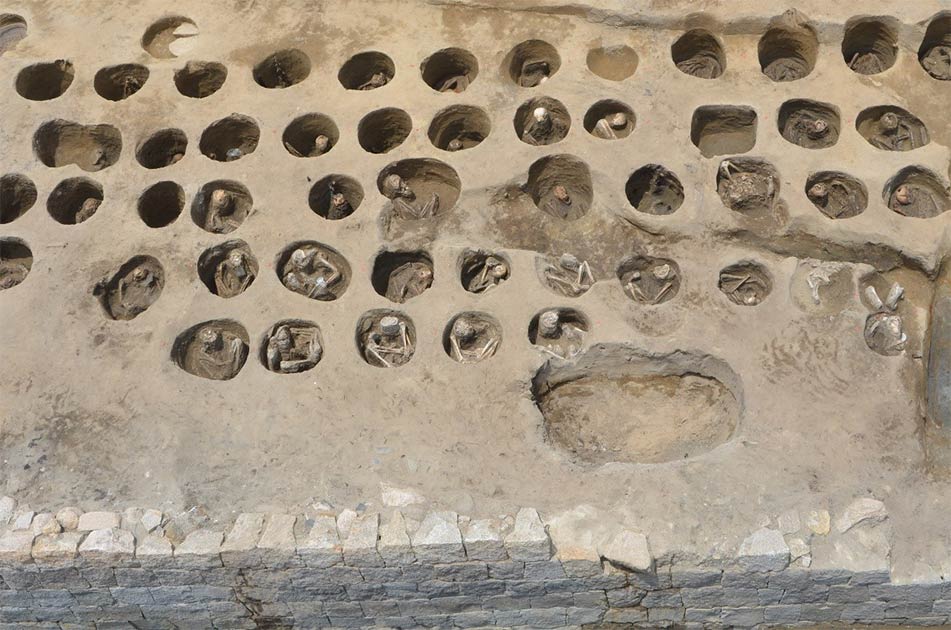Strange Historic Japanese Burial Ground Found In Downtown Osaka
In Japan, a graveyard has been unearthed in the heart of Osaka City. The Japanese burial ground is believed to have been an important historic graveyard that dates back several hundred years. The burial ground, condensed in a very small area, was unusual because of its circular graves. This extraordinary find is providing researchers with greater insight into life and death in Japan in centuries past. However, there are a number of unanswered questions about this Japanese burial ground that have perplexed researchers.
The burial site was unearthed north of JR Osaka station, during a construction project in a very busy district. Hyper Allergic reports that the discovery is “is akin to finding a burial ground right by New York’s Grand Central Terminal.” The graveyard was found during a construction work survey at a well-known historic site. It was discovered on “the former site of the ‘Umedahaka’ burial ground,” according to The Mainichi.
The Umedahaka Japanese Burial Ground Was Large And Ancient
The Umedahaka Japanese burial ground was first used in the early Edo period (1603-1868) and was still used as a burial site in the 1860s. The grounds were used for burials for almost three centuries. Umedahaka was one of Osaka’s seven main burial grounds. It was very well-known and is mentioned in several popular Japanese dramas and musicals. The burial ground area has the shape of an upside-down L.

Northern view of entire Umedahaka burial grounds which form an upside-down L shape. (Osaka City Cultural Properties Association / Osaka City)
During the survey 350 circular graves were unearthed. The remains of the dead were packed tightly into their graves and many were in a fetal position. In total 1500 skeletons were unearthed at the location. The dead were buried in tubs, coffins and some had been cremated and their remains placed in funeral urns.
Umedahaka: Cemetery For The Poor And Diseased
The Daily Mail quotes an Osaka City Council press release as saying that “In the northern part of the lower graveyard, simple burials that are bent over and stored in shallow holes or covered with soil.” Some of these graves were covered with only three feet (1 m) of earth. The Osaka City Council press statement reported that “Especially in the lowermost layer, a number of vertical holes in which multiple bodies were buried together were found,” according to the Daily Mail.
These shared graves may hold individuals who died of infectious diseases. There were many deadly disease epidemics in Osaka in the past, during which many people died during a short period of time. The Mainichi reports an expert as speculating that this part of the well-known burial ground “was used to bury people who had all died at once from diseases, among other things.”

The northern section of the Umedahaka burial grounds. (Osaka City Cultural Properties Association / Osaka City)
The people who are buried in the circular burials were probably poor and lived in downtown Osaka. There were no grave goods of any kind found in these graves, unlike those who came from the upper echelons of society. The Mainichi quotes Mikiko Abe, an anthropologist, as stating that “lesions primarily concentrated on the limbs were visible on close to 30% of buried individuals, and it's possible some of them suffered from syphilis and bone tumors.” Many had long term health problems and were in a poor physical state before their death and this may reflect their living conditions, which may have been unhealthy and unsanitary.
The survey results were compared to other findings from villages and another burial ground in Osaka. The majority of the Umedahaka dead had died young in their 30s and there were several children found interred at the site. Experts found that those buried elsewhere had fewer bone lesions and lived longer than average than those interred in Umedahaka, which was a surprise. Abe is quoted by The Mainichi as saying, “I was surprised at how different the results were from the city and rural villages.”
There are some unresolved mysteries about the graveyard. It is believed that the graves were moved in the 1680s from another area. Therefore, there is the possibility that the remains were deposited elsewhere for a time. The graveyard also revealed a large number of animal bones. Mysteriously, “Researchers also identified a bone from a cat, which was found contained within a human skeleton,” according to the Daily Mail.

A pile of funerary urns that were unearthed at the Umedahaka site. (Osaka City Cultural Properties Association / Osaka City)

An intact Buddhist mortuary artifact was also found at the site. (Osaka City Cultural Properties Association / Osaka City)
Umedahaka Will Be Moved But The Research Will Continue
The Mainichi reports Abe as saying that “By analyzing the bones found this time, and matching them with historical documents and other contemporary evidence, perhaps we'll be able to get a better sense of what Osaka was like in the Edo period.” The discovery is unique because of the number of graves and its urban location. This find could provide more insights into Edo and Meiji social history and in general. Both periods were of great importance in the pre-modern history of Japan.
- Sensoji Temple, Tokyo’s Throbbing Heart of Japanese Buddhism
- Medieval Japanese Weapons Influenced Culture Long After the Middle Ages
- Sensu and Tessen in Combat: A Japanese Fan Became a Deadly Weapon In the Right Hands
Investigations are continuing at the site and more insights could yet emerge. It is believed that the remains will be reburied elsewhere. The transfer and re-burial rituals will be performed by Buddhist monks. Hotels, apartments, and commercial premises are expected to be erected on the burial site once the transfer is completed.
Top image: Circular graves discovered in the southern part of the Umedahaka Japanese burial ground in Osaka’s Kita Ward. Source: Osaka City Cultural Properties Association / Osaka City
By Ed Whelan



















